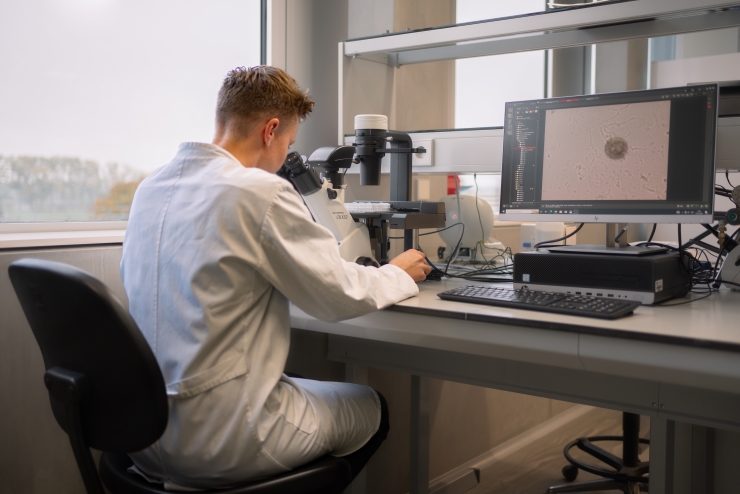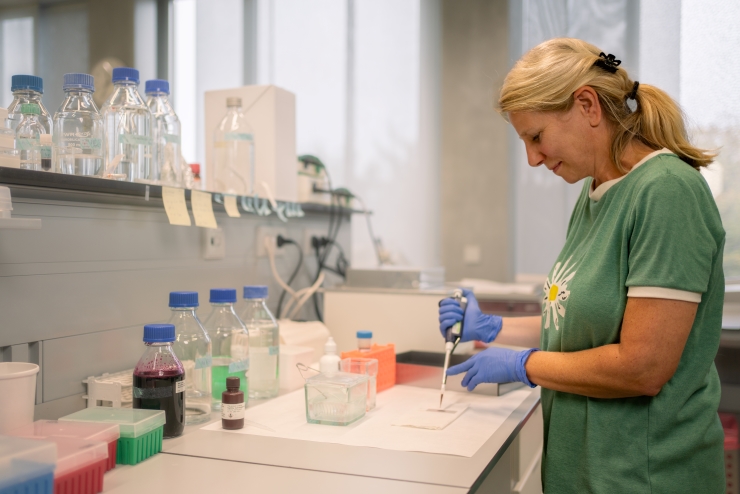Endocrine Oncology
Adrenal and pituitary tumors gain our primary interest. While these types of tumors are very similar to their human counterparts, there is one difference: in humans, these types of tumors fall into the category of rare cancers, while in dogs, they occur with significantly higher prevalence. The major problem in rare cancer in humans is the lack of access to appropriate therapies. Treating veterinary patients, on the other hand, generates tissue material and presents a unique opportunity to extend the number of samples for research purposes. Veterinary patients can help to close the gap in finding a better treatment for rare cancer in humans.
Pheochromocytoma
Unmasking pheochromocytoma
Canine pheochromocytoma (PCC) is an aggressive and life-threatening tumor from the adrenal gland. In the past few years, we introduced reference ranges for urinary and plasma metanephrines and significantly improved the biochemical diagnosis of canine PCC. The next step is improving the histopathological diagnosis and unraveling the pathogenesis of PCC with -omics approaches. The transcriptomics revealed some interesting data on prognostic factors of canine PCC, and this knowledge will be integrated into the histopathological evaluation of PCC and the development of a prognostic score. With whole genome sequencing, we aim to disclose the mutational status of canine PCC and to look for the similarities with human PCC to position the dog as an animal model to study human PCC.
The availability of canine PCC tissue for research purposes enables us to develop and validate an organoid model. As there is no medical treatment available to suppress the PCC tumor growth, we aim to use organoids for pre-clinical drug screening. Due to the similarities between human and canine PCC, this research might benefit both.

Andrenal Incidentaloma
Disclosing signature of adrenal incidentaloma
Adrenal incidentaloma (AI) is an adrenal mass discovered serendipitously by diagnostic imaging without clinical features suggestive of adrenal disease. Adrenal incidentalomas can be benign (and can be left in situ) or malignant (and deserve intervention), the dilemma for the clinicians, as so far, there are no guidelines on how to approach AI in veterinary practice.
In this project, we will evaluate the steroid metabolomic profile of AIs performed by liquid chromatography with tandem mass spectrometry in AI’s tissue. This will provide a steroid profile and enable us to judge on hormone activity of AIs objectively. The metabolic profile will contribute to a better understanding of the pathophysiology of AIs and may also allow us to introduce a novel endocrine diagnostic approach.
Furthermore, all AI will undergo pre-operative contrast-enhanced ultrasonography to determine if it is possible to judge the nature of adrenal mass preoperatively. This knowledge will be combined with the histopathological evaluation of AIs, including some immunohistochemical markers associated with prognosis (Ki67) and pathogenesis of AI (LHR).
This research will be the first to provide data to build an evidence-based guideline on managing AIs in veterinary practice.

Pituitary
CaPiTO: canine pituitary organoids as a tool for novel medical treatment options
Naturally occurring Cushing’s syndrome, caused by an ACTH-secreting pituitary adenoma (pituitary-dependent hypercortisolism; PDH) is one of the most common endocrine disorders in dogs. Current medical treatment of PDH only inhibits cortisol production, meaning that the pituitary adenoma can continue to grow and induce space-occupying neurological signs. Pituitary-targeting drugs therefore represent an unmet clinical need. Finding these drugs is hampered by the lack of suitable in vitro models that contain species-specific proliferating pituitary adenoma cells.
In cooperation with the Princes Maxima Center, we succeeded in culturing organoids of the (normal) pituitary gland and pituitary adenomas and tested several pituitary-targeting drugs. With this study, we expect to identify drugs with the highest pituitary-targeting potential reliably and to be able to introduce promising novel treatment options for dogs with PDH.




















